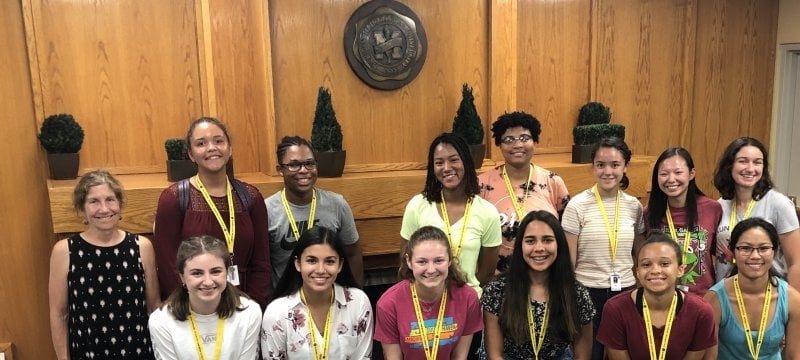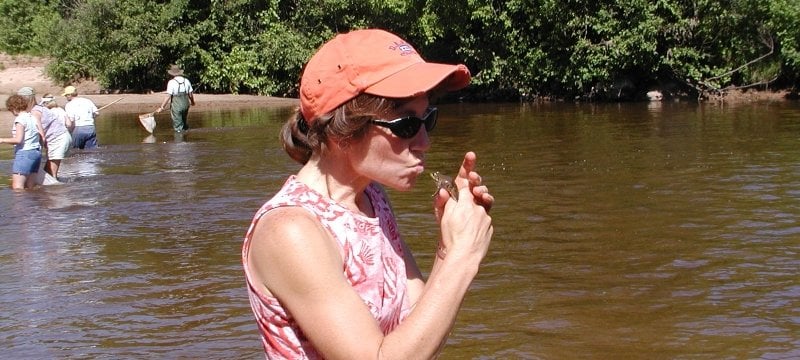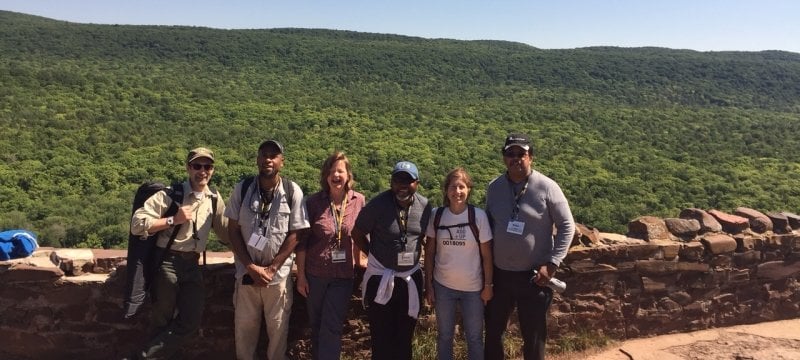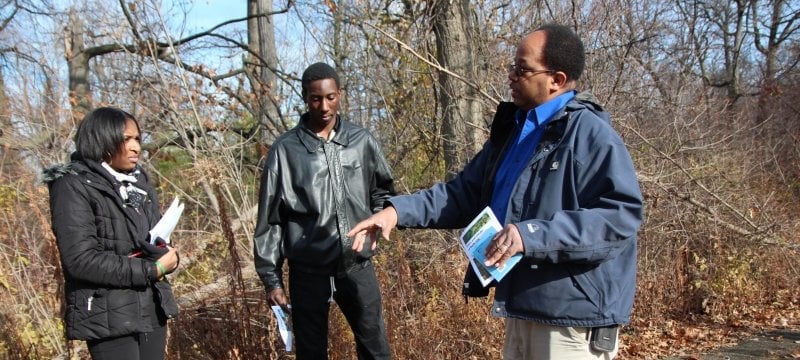Joan Schumaker-Chadde’s body of work is a lot like Lake Superior: the list of attributes,
no matter how complete, can’t fully articulate its depth and breadth.
Chadde’s 25-year history of serving teachers and students across the state of Michigan
with original and impactful outreach has been recognized with the 2020 Michigan Tech Diversity Award.
About the Award
Established in 2014, Michigan Tech’s Diversity Award showcases Michigan Tech faculty
and staff who demonstrate exemplary commitment to initiatives that forward diversity
and inclusion. Their contributions come in many forms, including recruitment, retention,
teaching, research, multicultural programming, cultural competency and community outreach.
The Diversity Award winner receives a $2,500 award and is honored during the annual
Faculty Awards celebration in September.
All are welcome to submit Diversity Award nominations, which are due by late May each year.
As a founding member of both the Diversity and Inclusion Committee of the statewide Michigan Alliance for Environmental & Outdoor Education (2016-present), and the Michigan Tech Civil and Environmental Engineering Diversity and Inclusion committee (2018-present), Chadde is most in her element when
she’s outdoors. But her work also requires resourcefulness and tenacity in the office:
It’s one thing to craft and operate programs and another thing entirely to fund them.
Chadde excels at both.
“As Director of the Center for Science and Environmental Outreach for the past 25 years, Chadde expands Michigan Tech’s educational influence far beyond
our campus boundaries,” said Diversity Council Chair and Interim Vice President for
Diversity and Inclusion Audrey Mayer. “Her Center’s programming for K-12 students from Calumet to Detroit draws new generations
to STEM fields every year.”
“She has ensured that all K-12 students can see a STEM future for themselves by connecting
them with Michigan Tech student members of the National Society of Black Engineers and the Society of Hispanic Engineers,” Mayer said, referring to Chadde’s organization of Michigan Tech’s Alternative Spring Break projects, in which students flip the traditional beach vacation script to embark on social
justice, humanitarian and educational missions.
In this Q&A, Chadde reflects on more than two decades of raising STEM education awareness
and bringing environmental and engineering programs to underrepresented communities
— an apt illustration of how a body of work speaks volumes.
Q: What’s your personal definition of diversity and inclusion?
JSC: Diversity means having people of diverse backgrounds — cultural, racial, ethnic,
economic and other experiences — participate and/or benefit in whatever the activity
or community might be. Diversity suggests a wealth of new ideas that enrich and improve
our lives. Inclusion means making people feel welcome and valued.
There is an additional dimension to both diversity and inclusion: equity. Equity is
vital to diversity and inclusion because it connects to justice. Places, programs
and opportunities need to be equally accessible to all, and all participants must
have an equal chance of success.
Q: What is the work you do, specifically related to diversity and inclusion?
JSC: I’ve worked on a range of programs focused on diversity and inclusion for K-12
teachers and students in Michigan and enlisting MTU students to help since 2008.
As the director of a wholly grant-funded Center established in 1991, I’ve had the
opportunity to design my own projects and then seek funding. We focus on environmental
and STEM education.
I began increasing our concentration on reaching underrepresented students in 2008
— it’s grown to be a large part of my work. In the past 12 years, we have delivered
programs to Native American students in the Upper Peninsula, and Black and Latinx
students in downstate urban areas where there are more people and a great need. We’ve
provided dozens of programs for students and teachers in Detroit.
“We are so lucky to have Joan Schumaker-Chadde, a passionate and successful STEM outreach
professional. By 2019, her programs had reached more than 10,000 K-12 students, teachers
and community members per year.”
Teaching the Teachers
For young people, the opportunity to see someone who looks like you leading and succeeding
opens the doors to possibilities. When it comes to recruiting and retaining Black,
Indigenous and other people of color into the teaching profession, Chadde says progress
has been made, but more needs to be done.
As an example, consider Michigan’s largest city, Detroit — most recent population
estimate 667,272 and three times larger than the second-largest city, Grand Rapids. Detroit’s 2014-15 school year demographics were 83% Black, 13% Hispanic, 2% white and 2% other,
while Michigan’s overall student population is 18% Black. Like the rest of the U.S.,
the state of Michigan’s teaching force is predominantly composed of white teachers (92%), with the next largest
group, Black/African American teachers, comprising only 6% of teachers and all other
underrepresented groups (1% or less). In Detroit schools, 82% of the students are
Black compared with 67% of teachers.
Q: You work with both educators and students. What’s most rewarding about each? What’s
challenging?
JSC: At a virtual meeting just last week, a Detroit public school teacher commented,
“Joan Chadde’s workshops and field trips inspired me to start teaching outside the
walls of my brick and mortar classroom.” Another Detroit teacher who has participated
in several of our environmental education workshops at the Belle Isle Nature Center
in Detroit beginning in 2014 has grown immensely professionally, presenting at education
conferences and taking on other leadership roles as well attending teacher trainings
from Maine to Wyoming. She’s applying to PhD programs — I wrote her a letter of recommendation!
It’s very satisfying to see underrepresented students get excited about outdoor recreation.
Some have never had the opportunity to mountain bike, kayak and hike — spending time
outdoors can help get them interested in natural resource or engineering careers they’ve
never been exposed to before. As a teacher friend says, “We have to get students to
love the resource before they will want to protect (steward) it.”
I work with two Black natural resource professionals from Detroit who come to MTU
to mentor high school youth during a week on campus. This is a huge value-added opportunity,
as they provide continuity by continuing the mentoring relationship when they return
to Detroit. Also, because MTU has few faculty and staff who look like the students,
it’s critical for them to have role models that they can relate to.
“I find myself playing the role of facilitator. I am not the best messenger, but I
can connect the students to a person they can trust.”
Last summer, we had an amazing group of 13 high school STEM interns at Michigan Tech
who participated in the five-day internships on a wide variety of topics. Many kudos
to the faculty, graduate students and departments and colleges who helped to make
this possible. On the last day, the students gave short presentations about what they
learned. Their grasp of the subjects were sometimes over my head!

last-day presentations describing their research and campus experiences. (All story
images courtesy Joan Chadde-Schumaker)
“From Detroit to the Western UP, Joan has worked tirelessly to bring opportunities
to underserved students and educators in her work directing the Center for Science
and Environmental Outreach. The Lake Superior Stewardship Initiative is only one part
of her work. She’s worked hard to expand learning about Anishinaabe culture, natural
resources and history through several LSSI workshops and has secured funding to transport
students from L’Anse, Baraga, Watersmeet, Hannahville, etc. to campus for LSSI’s Water
Festival.”
Q: What are the challenges the programs face?
JSC: It is always challenging to find the necessary funds to do these programs — a
lot of grant writing is essential. I am grateful to the many Michigan Tech departments
and colleges who provide financial support and cost share when asked. In addition,
many of my programs depend upon Michigan Tech faculty to be presenters. MTU faculty
were essential in being able to provide five-day STEM internships on campus. It was
a big ask, because they had to host the interns. Each department provided $600 per
intern to cover rooms, meals and transportation.
“Joan’s passion, creativity and perseverance are clearly demonstrated by the wide
variety of programming, audiences, geographic areas and partners she has touched.”

mission. “The natural resource career path is the least diverse,” she notes. “It’s essential to
inspire youth to consider careers in water and air quality, forestry, wildlife, fisheries, environmental engineering and more.”
Q: You’re also Michigan’s 2020 Informal Science Educator of the Year. I’ve experienced firsthand that you know how to organize an outstanding field trip!
What are some of the most interesting excursions you’ve organized for educators? For
young people?
JSC: The most interesting excursions I organized for educators were the five-day traveling
summer institutes. I organized at least a half dozen Maritime Transportation Teacher
Institutes — every summer from 2006 to 2013. For a few years, I conducted two per
summer! I moved the institutes around, from Duluth, Minnesota, to Door County, Wisconsin,
to Toledo, Ohio, and the eastern UP.
“I’d pile 12 teachers in a MTU van and it felt like we were off on vacation!”
It was all super fun! It’s enjoyable to reflect on these now, but they were a ton of work! I was pretty much a one-person show to keep costs down: making all of the
arrangements, planning the itinerary, managing the budget, recruiting the teachers,
grading their lessons and writing the grant report. But it was all worth it for the
teachers and for me!

Mountain.
For young people, I felt the six-day Natural Resource and Engineering Exploration Program (2015-2019) was very
worthwhile. I worked with Detroit partners Lisa Perez with the U.S. Forest Service
Urban Connections Program and Mike Reed with the Detroit Zoological Society as well
as Bruce Ross in Ypsilanti, Michigan, to bring 20 underrepresented high school students
to the Upper Peninsula and Michigan Tech to explore STEM career opportunities. Again,
it was a lot of work to raise the funds, recruit the students, design the program, invite the
presenters and coordinate the program on campus.
“I have always believed in respecting and working to ensure all people’s rights to
live in an equitable society.”

an inspiration for Chadde about the power of connecting young people with mentors
who look like them.
Q: What (or who) inspires you to dedicate time to improving diversity and inclusion
at Michigan Tech, and across the state and nation?
JSC: Mike Reed, curator of education and informal programs for Detroit Zoological Society (DZS), has been a terrific partner and colleague for more than 10 years. He was the director of the DZS Belle Isle Nature Center when we first met. We’ve
hosted more than three dozen teacher workshops there. Mike is a window into the reality
that Black people face each day. It is strange (shocking!) to realize that people
of color and women are still having to break glass ceilings in the United States in
2020. Mike has helped recruit Black high school students to participate in the six-day
Natural Resource and Engineering Career Exploration at MTU for the past five years.
He is a super Michigan Tech cheerleader, who has been attending the MTU A-4 (African
American Alumni Association) Picnic in Detroit for the past five years at the Detroit Yacht Club. The picnic is attended by African-American alumni, current students and prospective students and their parents.
Mike advises that it’s important to remember that we’re recruiting parents as much
as students. Parents have to feel confident that MTU is a welcoming place for their
child.
It’s essential that students can see themselves in engineering and natural resource
careers, and feel welcome. Detroit has both the largest number and largest percentage
of Black residents in the U.S. I am hopeful that Michigan Tech will have an office
in Detroit sooner rather than later to be more visible to parents and students. Many
other Michigan Universities have a presence in the D.
Q: What opportunities does this award open up?
JSC: This award is affirming of the work that I’ve done for the past decade and longer.
I am appreciative of Michigan Tech’s acknowledgement and support. I hope this opens
some doors and that the publicity spawns some new partners.
Q: Diversity and inclusion are as much a part of the public dialogue as they’ve ever
been. We’re at a moment in time when there’s a discernible shift in acknowledging
systemic racism and taking action to make permanent change. How can we as a campus
community move forward?
JSC: We need more Black, Latinx and Native American students on campus — and they
have the same need as the Center for Science and Environmental Outreach — funding!
Incoming students need to receive full scholarships. A college education is a ticket
to a better future, but not if it means going into debt in a big way. Students from
groups who have been traditionally underrepresented in higher education can find it
harder to get a job due to systemic racism in the workplace, so for them, pursuing
a college degree has the potential to be an even greater financial risk.
Systemic racism is a centuries-old problem that is going to take a long time to fully
address. We need to keep working diligently. Many students are the first in their
family to attend college. They need support getting to college, staying in college
and navigating careers after college.
Communication is key: Providing programs to help faculty, staff and students look
inside themselves and gain a greater understanding of their role in continuing racism
is an essential step.
And, finally, it’s also vital to work with our youngest children and provide opportunities
for elementary students to have diverse teachers and presenters, and interact with
diverse students, so they are comfortable and see it as the norm. Teachers can post
diverse faces of scientists, engineers, writers, artists, etc. in their classroom.
The message is powerful: Showing a greater variety of people provides more perspectives,
creativity and a more effective team to tackle our country and the world’s challenges.
Michigan Technological University is a public research university, home to more than
7,000 students from 54 countries. Founded in 1885, the University offers more than
120 undergraduate and graduate degree programs in science and technology, engineering,
forestry, business and economics, health professions, humanities, mathematics, and
social sciences. Our campus in Michigan’s Upper Peninsula overlooks the Keweenaw Waterway
and is just a few miles from Lake Superior.






More Stories
MP3 Players – Knowing the Various Interesting Facts About These Gadgets
How Hotels Can Cope Up With the Airbnb Generation Through Information Outsourcing
Roaring Machines – James Bond Vehicles